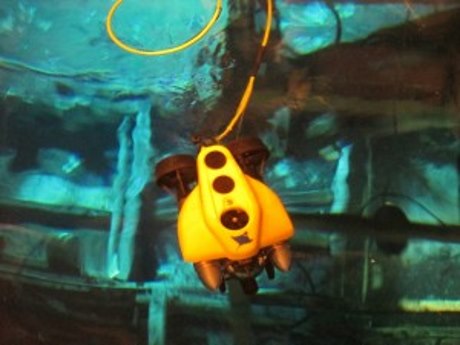UK regulators have confirmed that Sizewell A is completely fuel free. The decommissioning milestone marks the removal of 99% of the radioactive hazard from the former Magnox nuclear power station.
 |
| Underwater inspections confirmed that Sizewell A's ponds were empty of nuclear fuel (Image: Magnox Ltd) |
Sizewell A's two 210 MWe Magnox gas-cooled reactors operated from 1966 until 2006. Defuelling began in 2009, with fuel removed from the reactors placed in the site's used fuel storage ponds before being packaged in transport containers for shipment to the Sellafield complex for reprocessing. The final flask of fuel was shipped to Sellafield in August 2014.
A rigorous verification process has now been completed to confirm that fuel has indeed left the site. Remotely operated underwater vehicles were used to check that all of the ponds at Sizewell A are now empty.
The Office for Nuclear Regulation (ONR) has now accepted that the site is fuel free, confirming the reduction in the radioactive hazard and allowing the site to move to the next step of its decommissioning program, preparation for care and maintenance (C&M). During this phase, the focus will shift onto decommissioning and removing equipment and machinery from buildings as well as retrieving, treating and processing any waste.
Sizewell A is operated by Magnox Limited, itself owned and operated by Cavendish Fluor Partnership Limited on behalf of the UK Nuclear Decommissioning Authority (NDA). NDA head of programmes Brian Burnett congratulated the Magnox team on its achievements. "This confirmation by the ONR marks an important hazard reduction milestone on Sizewell A's path towards care and maintenance," he said.
The Sizewell A site will enter the C&M phase in 2027, when the remaining structures will be kept in a passively safe and secure state to allow radiation levels to naturally decay over time. During this phase the site will be monitored and maintained until final site clearance begins around 2088. The types of buildings that will remain on site typically include so-called safestores which contain the defuelled and extensively decommissioned reactors themselves, intermediate level waste stores or interim storage facilities as well as any additional structures that will be removed at final site clearance.
Researched and written
by World Nuclear News




_18570.jpg)
_16159.jpg)
_18938.jpg)
_33584.jpg)





